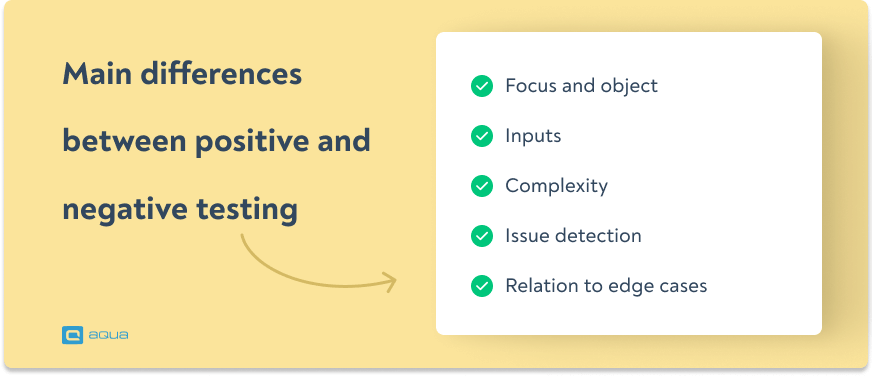What is Positive Testing?
Positive testing is like checking if your app works when everything goes according to plan. It’s the “happy path” testing where you validate that your software behaves correctly under ideal, expected conditions.
Purpose of Positive Testing
Positive testing confirms that your application works as designed when users follow the rules. It’s about making sure the core functionality delivers on its promises.
When you perform positive testing, you’re essentially asking: “Does this feature work when used exactly as intended?” You’re checking that the software meets its requirements and that users can complete tasks when they follow the expected workflow.
Think of positive testing as making sure your car drives properly when you follow all the traffic rules: staying in your lane, obeying speed limits, and using turn signals correctly. You’re not trying to break anything; you’re verifying that everything functions when used properly.
Example of Positive Testing
Let’s say you’re testing a login form. Positive testing would involve scenarios like:
- Valid credentials test: Enter “john@company.com” and “SecurePass123!”, the system should authenticate instantly and redirect to the dashboard without errors or delays.
- Login button functionality: Click the primary login button after entering the correct credentials. Verify it triggers authentication, shows appropriate loading states, and doesn’t allow double-submission.
- Post-login navigation: Confirm users land on their personalised dashboard with correct user data, proper navigation menu, and no broken elements or missing permissions.
- “Remember me” persistence: Check the checkbox, log out, return to the site, and your credentials should auto-populate, and you should stay logged in across browser sessions for the expected duration.
- Password masking security: Verify that password characters appear as dots or asterisks as you type, can’t be copied to the clipboard, and don’t appear in browser developer tools or form data.
Take an e-commerce checkout flow as another example. Positive tests would include:
- Adding items to the cart
- Entering valid shipping information
- Submitting payment with valid credit card details
- Confirming that the order completes successfully
- Verifying that order confirmation emails are sent
Positive testing forms the foundation of your testing strategy. It ensures that your application’s primary functions work correctly for users who follow the expected path. Without solid positive testing, you can’t be confident in your software’s basic functionality.
What is Negative Testing?
Negative testing is where you intentionally try to break your application by doing things users shouldn’t do, but inevitably will. It’s about predicting user errors, unexpected inputs, and edge cases to ensure your application handles them gracefully. Software negative testing is essential for identifying potential vulnerabilities before they become problems.
While understanding positive and negative testing concepts is straightforward, implementing them presents significant challenges. Teams often struggle with creating comprehensive test cases that cover both valid and invalid scenarios, tracking which negative edge cases have been tested, and ensuring consistent execution of both testing types across different components. Without proper organisation, negative testing scenarios, which are often more complex and numerous than positive ones, frequently get overlooked or poorly documented. This leads to gaps in test coverage that can result in production failures.
This is where a robust Test Management System (TMS) becomes crucial for balanced positive and negative testing strategies. aqua cloud’s AI-powered test case generation can rapidly create both positive and negative test scenarios in seconds, delivering comprehensive coverage of valid inputs and edge cases. Its centralised hub manages both manual and automated testing efforts, while native integrations with tools like Jira, Selenium, and Jenkins maintain complete traceability across all test types. With aqua cloud’s bug-tracking and recording capabilities, you can efficiently capture and correlate defects discovered through negative testing. Ensuring both successful validations and failure scenarios are properly documented and tracked will become a breeze with aqua. So what’s keeping you from trying it out?
Cover 100% of your both positive and negative tests effortlessly
The main goal of negative testing in software testing is to prevent your application from crashing, corrupting data, or exposing security vulnerabilities when faced with invalid inputs or unexpected scenarios.
Negative testing answers questions like: “What happens when users do something they’re not supposed to do?” or “How does the system respond when something goes wrong?” This approach helps you build resilience into your software by identifying potential failure points before users encounter them.
Unlike positive testing (which confirms things work), negative testing confirms that things fail correctly. It’s like making sure your car’s airbags deploy properly during a collision – you hope users never experience it, but you want proper safeguards in place if they do.
Example of Negative Testing
For a login form, negative testing scenarios might include:
- Invalid credentials handling: Enter “fake@email.com” with “wrongpass” – the system should show a clear error message, not reveal whether the username or password was incorrect, and implement rate limiting after multiple attempts.
- Empty field validation: Submit the form with blank username/password fields – verify that appropriate field-specific error messages appear instantly, form submission is blocked, and focus moves to the first empty required field.
- Input length boundary testing: Paste a 10,000-character string into the username field – the system should either truncate input gracefully, show a character limit warning, or handle the oversized data without crashing or causing database errors.
- SQL injection prevention: Enter ‘; DROP TABLE users; — in the username field – the system should treat this as literal text, not execute any database commands, and either sanitize the input or safely reject it with an error message.
- Authentication bypass attempts: Manually edit browser cookies or localStorage tokens, or try accessing protected URLs directly – the system should detect invalid/expired tokens, redirect to login, and never grant unauthorised access to user dashboards.
For an e-commerce checkout system, negative tests could include:
- Entering invalid credit card numbers
- Using expired credit cards
- Attempting to order negative quantities
- Submitting special characters in shipping address fields
- Testing what happens when the payment processor is down
A good negative testing approach anticipates user mistakes and system failures. It helps create a more robust application that can handle unexpected inputs and scenarios, making for a better user experience even when things don’t go as planned. Negative testing in software is particularly important for security-critical applications where failure can have serious consequences.
Key Differences Between Positive and Negative Testing
Now that you’ve seen how both approaches should work, you might be wondering: what exactly sets them apart? While positive and negative testing both aim to improve software quality, they take fundamentally different paths to get there. Think of them as two investigators working the same case, one follows the evidence where it leads, the other assumes everyone’s lying and digs for what’s hidden. Understanding these differences helps you develop a comprehensive testing strategy that balances both approaches for optimal software quality. The relationship between positive and negative testing is complementary rather than competitive.
Focus and Objective
Positive Testing:
- Focused on validating that the software works correctly with valid inputs
- Aims to confirm that the firm’s expected functionality works as designed
- Tests are designed around functional requirements
- Goal is to verify the software does what it should do
Negative Testing:
- Focused on validating how software handles invalid or unexpected inputs
- Aims to find defects and vulnerabilities
- Tests are designed around potential failure points
- Goal is to verify the software doesn’t do what it shouldn’t do
Inputs
Positive Testing:
- Uses valid, expected inputs within normal parameters
- Follows documented workflows and user journeys
- Input data matches specifications
Negative Testing:
- Uses invalid, unexpected, or malformed inputs
- Tests boundary conditions and edge cases
- Input data intentionally violates specifications
Complexity
Positive Testing:
- Generally more straightforward to design and execute
- Test cases are derived directly from requirements
- Often follows a linear, predictable path
Negative Testing:
- Usually more complex and creative
- Requires thinking beyond the requirements
- Often explores non-linear, unpredictable scenarios
Issue Detection
Positive Testing:
- Detects issues with core functionality
- Finds problems in the main user flows
- Identifies gaps between requirements and implementation
Negative Testing:
- Detects issues with error handling and validation
- Finds vulnerabilities and security issues
- Identifies unexpected behaviours and edge case problems
Relation to Edge Cases
Positive Testing:
- Typically does not focus on edge cases
- Stays within the boundaries of expected behaviour
Negative Testing:
- Actively targets edge cases and boundary conditions
- Pushes the limits of the application

A general rule I use is finding the exact opposite of what is intended.
Simple Example: we have a field that accepts a range of 1 - 100
Positive: we enter in a good number, say 53, make sure it's accepted/saved/etc
Negative: we enter in a trash number, make sure we get a proper error
Comparative Table: Positive vs. Negative Testing
Let’s look at the differences in a comprehensive table, so you can use it as a complete reference to understand:
| Aspect | Positive Testing | Negative Testing |
|---|---|---|
| Definition | Testing with valid inputs to verify correct functionality | Testing with invalid inputs to verify proper error handling |
| Goal | Confirm the software does what it should | Confirm the software doesn’t do what it shouldn’t |
| Test Data | Valid inputs that comply with requirements | Invalid inputs that violate requirements |
| Coverage Focus | Main functionality and user flows | Error handling, validation, and edge cases |
| Common in | Initial development phases | Later testing phases, security testing |
| Documentation Source | Requirements specifications | Error handling specs, security requirements |
| Complexity | Generally straightforward | Often more complex and creative |
| Test Cases Volume | Usually fewer test cases | Usually more test cases (many ways to break) |
When to Use Positive or Negative Testing
Picture an experienced QA engineer staring at a new feature, coffee in hand, wondering: “Do I test this like a careful user or like a digital vandal?” The answer isn’t always obvious, and choosing wrong can mean the difference between catching a critical bug and shipping a ticking time bomb. Here’s your decision-making playbook for navigating these crucial moments:
Evaluation Criteria for Choosing Testing Approaches
Use Positive Testing When:
- Validating core functionality during initial development
- Confirming that new features meet basic requirements
- Performing acceptance testing with stakeholders
- Running regression tests on critical user journeys
- Testing happy paths that most users will follow
- Demonstrating functionality to stakeholders or clients
Use Negative Testing When:
- Assessing security vulnerabilities
- Testing input validation and error handling
- Evaluating system stability under unexpected conditions
- Working with features that handle sensitive data or transactions
- Testing integrations with external systems
- Preparing for production deployment
- Dealing with features used by diverse user groups
Consider Both When:
- The feature has high visibility to users
- The functionality handles financial transactions
- There are complex data transformations
- The feature interacts with multiple systems
- You’re working in highly regulated industries
- Time or resources are limited and you need to prioritise
Positive and negative testing in software testing should be viewed as complementary approaches, as each one addresses different aspects of application quality. The implementation of negative testing in software should focus on validating how well your application handles unexpected scenarios.
Phase of Development
Imagine your software as a house being built. You wouldn’t install the security system before laying the foundation, right? Different phases of development call for different testing strategies, and timing your approach wrong is like painting the walls before fixing the plumbing. Here’s how to sync your testing strategy with your development timeline:
Early Development Phases:
- Start with positive testing to verify that core functionality works
- Implement basic negative tests for critical input validation
- Focus on building a solid foundation before exploring edge cases
Mid-Development Phases:
- Balance positive and negative testing
- Expand negative testing to include more edge cases and error conditions
- Use feedback from early testing to refine both approaches
Pre-Release Phases:
- Comprehensive positive testing to ensure all requirements are met
- Intensive negative testing to uncover potential issues before users do
- Penetration testing and security-focused negative tests
- Load testing with both valid and invalid scenarios
Maintenance Phases:
- Regular positive tests as regression testing
- Targeted negative tests when bugs are reported
- New negative test scenarios based on actual user behaviour
Decision Framework for Test Selection
Every feature lands on your desk with its own personality: some are straightforward team players, others are complex troublemakers waiting to cause chaos. Smart testers know that a one-size-fits-all approach is incomplete and will bring a lot of problems later. You need a systematic approach to sizing up each feature and choosing your testing weapons accordingly. To help determine which testing approach to use, consider this flowchart-inspired decision process:
1. Identify the feature’s risk level
- High risk (financial, security, data integrity) → Need both, with extensive negative testing
- Medium risk → Balance of positive and negative tests
- Low risk → Primarily positive tests with basic negative tests
2. Evaluate the feature’s complexity
- Complex features with many variables → More negative testing
- Simple, straightforward features → Focus on positive testing
3. Consider user impact
- Features used by all users → Both testing types
- Admin or internal features → Focus on positive testing
- Features handling sensitive information → Enhanced negative testing
4. Assess time constraints
- Limited time → Focus on positive tests for core functionality
- Adequate time → Comprehensive coverage with both approaches
5. Review resources available
- Experienced testers → More sophisticated negative testing
- Limited QA resources → Automate positive tests, manually focus on negative scenarios
Remember that the most effective testing strategies incorporate both positive and negative testing in proportions appropriate to your specific project’s needs. For critical systems, negative test case development deserves just as much attention as positive scenario testing.
The decision-making process for when to implement positive versus negative testing becomes even more complex in real-world scenarios. Here, you must balance thorough testing with project timelines and resource constraints. Many teams struggle with prioritising which negative test cases to execute first, tracking the effectiveness of their positive testing coverage, and ensuring that both testing types are consistently applied across different development phases.
Modern test management platforms like aqua cloud address these challenges by providing intelligent test planning and execution capabilities. aqua cloud’s 100% traceability and coverage visibility help you identify gaps in both positive and negative testing scenarios, while its AI-powered capabilities (super-fast test case, test data, and requirements creation) allow you to create optimal test case combinations. The platform’s seamless integration with automation tools like Selenium, Jenkins, and Ranorex enables teams to efficiently execute repetitive positive tests while dedicating manual testing resources to complex negative scenarios. With 100% visibility into test execution progress and results correlation, aqua cloud ensures that both positive and negative testing strategies are implemented systematically and effectively throughout the development lifecycle.
Streamline your positive and negative test management with 100% AI-powered solution
Integrating Positive and Negative Testing in Your Strategy
Creating a balanced testing approach means strategically combining both methodologies for maximum effectiveness. Positive and negative testing in software testing complement each other and should be used together.
Building a Comprehensive Test Plan
A well-rounded test strategy should:
- Start with positive testing to establish a baseline of functionality
- Layer in negative testing to strengthen the application’s defenses
- Prioritize critical paths for both positive and negative approaches
- Allocate adequate time for both test types in your test plan
- Document expected outcomes for both valid and invalid scenarios
Try this approach when creating your test plan:
- Map out all core user journeys (positive tests)
- For each journey, identify potential failure points
- Create negative tests for each failure point, including examples of negative test cases
- Prioritize based on risk and user impact
- Automate repeatable tests where possible
- Schedule regular reviews of both test types
Automation Considerations
You’ve probably heard the age-old QA dilemma: “Automate everything!” sounds great until you realize some tests fight automation like a cat fights a bath. The truth is, positive and negative tests each have their own automation personalities – some practically automate themselves, while others need the human touch. Here’s how to build an automation strategy that plays to each approach’s strengths. Both positive and negative testing benefit from automation, but in different ways:
Positive Test Automation:
- Excellent for regression testing
- Easier to automate due to predictable outcomes
- Creates a safety net for future development
- Often implemented as end-to-end tests
Negative Test Automation:
- Great for input validation testing
- Can be parameterized for many invalid input combinations
- Useful for repeated security testing
- Often implemented as unit or API tests
A balanced automation strategy might look like:
- Automate 80-90% of positive test cases
- Automate common negative scenarios (invalid inputs, empty fields)
- Manually test complex negative scenarios that are difficult to automate
- Use property-based testing for generating varied invalid inputs
Real-world Testing Balance
Walk into any QA team meeting and you’ll hear the eternal question: “How much testing is enough?” The answer changes depending on whether you’re protecting someone’s credit card or their high score in Candy Crush. Industry experts know that getting this balance wrong can mean the difference between sleeping soundly and getting 3 AM phone calls about broken systems. Here’s what the testing ratios look like across different industries. Different product types require different positive/negative testing ratios:
- E-commerce platforms: 60% positive / 40% negative (focus on checkout flows)
- Banking applications: 50% positive / 50% negative (equal emphasis due to security concerns)
- Content management systems: 70% positive / 30% negative (core functionality is key)
- Healthcare systems: 40% positive / 60% negative (data integrity and security are critical)
- Gaming applications: 80% positive / 20% negative (user experience is paramount)
The ideal ratio depends on your specific product, risk tolerance, and user expectations. When implementing negative testing in software, it’s important to understand what is negative testing means in the context of your specific application domain.
Conclusion
Positive and negative testing are complementary techniques that together create a robust quality assurance strategy. Like checking both the locks and the alarm system in your home, they secure your application from different angles.The most effective testing strategies include both approaches in a balanced way, adjusted for your specific application’s risk profile and user needs. By understanding when and how to apply each testing type, you’ll build more resilient applications that can stand up to real-world use. Remember, your users will inevitably find ways to use your software that you never anticipated. By combining positive testing’s validation of the expected with negative testing’s exploration of the unexpected, you’ll catch more issues before release and deliver a more polished product to your users.


















